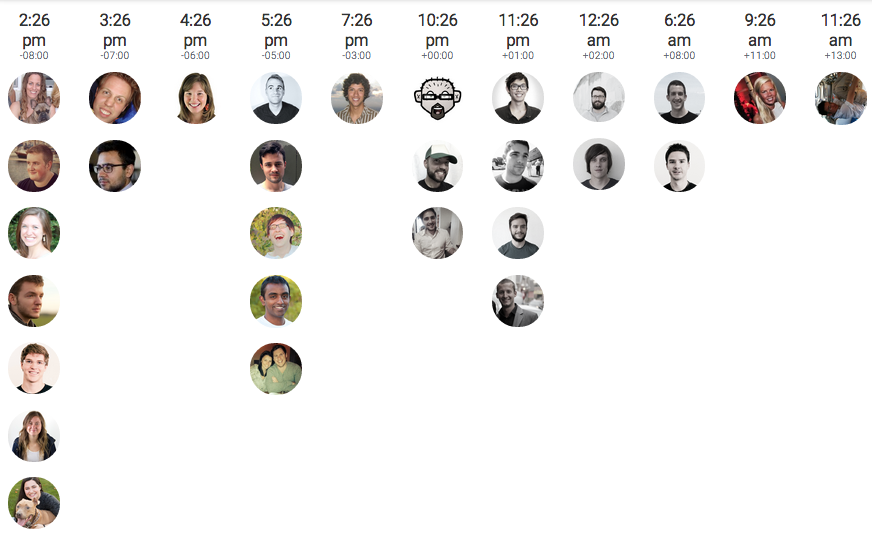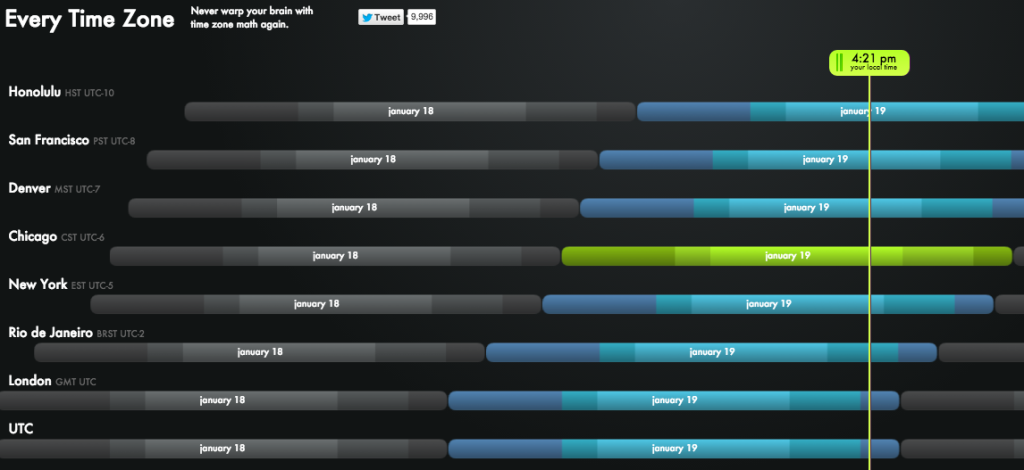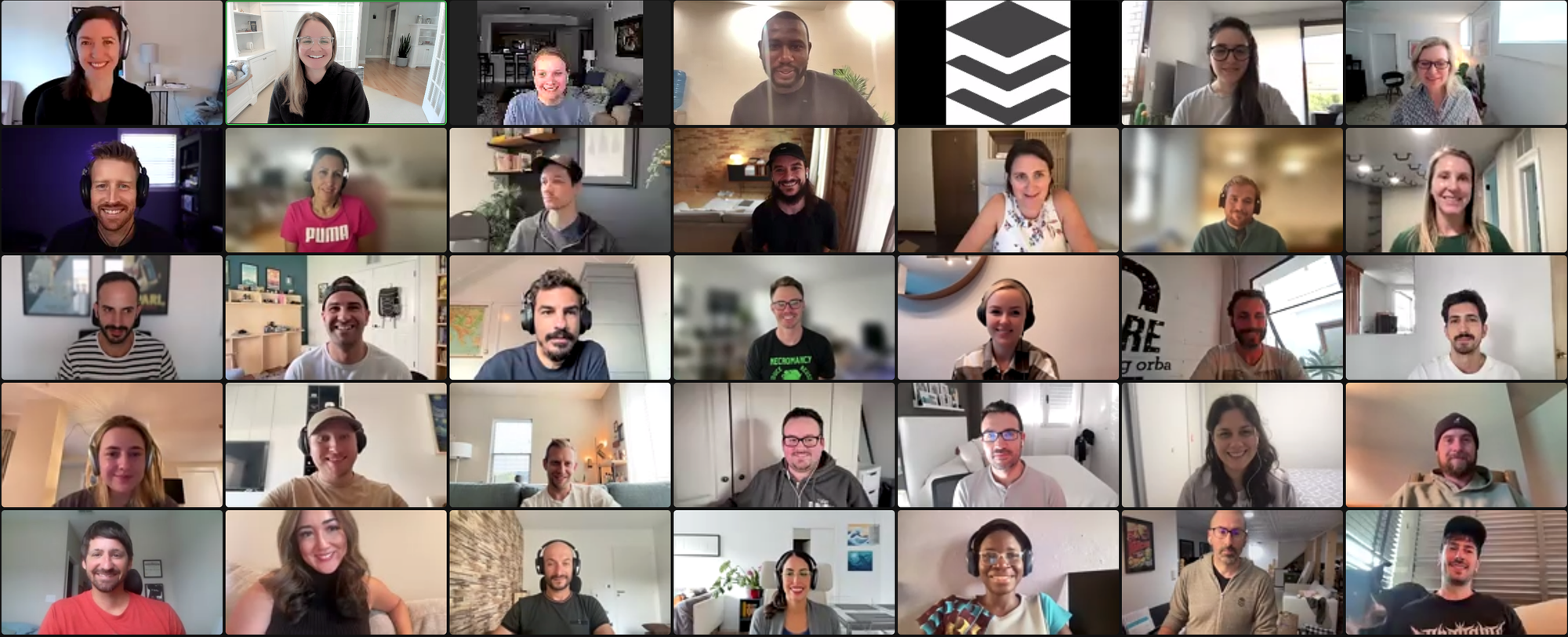
Working Across Multiple Time Zones: Tools and Strategies That Help Connect
Former Director of People @ Buffer
There are many features of the world that I simply cannot wrap my head around, and one of these has always been time zones.
Teammates I work with every day who live in Singapore and Australia are a whole day ahead of me in the USA. Wild!
In addition to confounding my brain, time zones also provide some fun and interesting challenges when it comes to how we all work together at Buffer as a fully remote, distributed team.
For instance, here’s a glimpse at what our team looked like a while back, spread out across 11 different time zones!

Naturally, this fact changes the way we work just a bit. And as our team grows and changes, we sometimes have to change and renegotiate the way we work through time zones.
Here are some of the strategies I’ve noticed that seem to be the most effective for us in working across multiple time zones. Maybe they’ll help your remote team, too!
Awareness of others’ time zones
Possibly the simplest tip of all is also the one that can be the hardest to keep top of mind. Typically, we try to be mindful of what time it is for others when we use synchronous communication like video or Slack. This keeps us from asking a teammate to dive into a brand-new project if they’re just about to jump off for their evening, for example.
The tool shown above is one that our awesome developer Dan made just for Buffer, and it helps us all a ton to know what’s going on with any teammate at a glance. (If you’re a developer yourself and want something similar, he’s made the code available on Github).
Another handy one, especially if you’re planning a meeting across time zones, is Every Time Zone, which allows you to toggle around to see what the time of your choosing is across every time zone.

World Time Buddy works similarly. In this one, you can type in specific places and time zones to get exact times for those who may not be in the major cities.

Using these tools to keep time zones top of mind makes sure that all team members have an equal opportunity to work smarter, not harder, and that they can engage or disengage when they want.
Prioritizing asynchronous communication
We use a variety of tools at Buffer, many of which we’ve blogged about before. For synchronous, everyone-at-the-same-time communication, we use Slack for written chats and Zoom for video chats.
We also have a lot of tools for asynchronous, everyone-at-their-own-pace communication, including Threads, Trello and Paper. In these tools, we can log what we’ve done, what we’re doing or questions and comments we have and know that other team members can read and comment later on their own schedule.
One of our challenges as a team is to strike the right balance between synchronous and asynchronous communication.
Asynchronous communication is important to be inclusive across time zones and schedules, to make sure we hear from introverts, too, and to make sure everyone gets time to focus.
I know personally, I sometimes like to get stuck in at various points in my day for focused work without too many distractions. But after that I like to switch out to focus on chat, etc. Scheduled synchronous communication like planned video calls/syncups allow me to better mentally prepare.
Meeting in smaller groups
Although we prioritize asynchronous communication, it’s still awesome when we can talk face-to-face with teammates.
We have a few standing methods of making sure these types of communication happen often, including the daily pair call and weekly or biweekly mastermind chats. These chats are normally only 2-3 people maximum, so more often than not it’s possible to find a time that works for everyone across multiple time zones.
And although it’s not totally unheard of to see an ad hoc meeting come together in Slack, we’re trying harder to make sure to schedule a specific time in advance when we need to communicate synchronously so we can all plan for it.
Sharing travel plans and schedule changes
When you’re not in the same place with your teammates and you don’t have set work hours, one thing that becomes really important is frequent, clear communication.
We’re constantly sharing what’s going on with our lives and schedules, whether we’re popping out to grab some tacos at lunch or spending the next 4 months in Costa Rica.
Not only does this help the rest of the team to be aware of any changes they might need to know, it also has the added benefit of helping us all feel more connected to one another as we share plans and details of our lives. Not to mention, we wind up collecting some stellar travel tips from our digital nomad teammates!
Getting together regularly in one place
It’s truly amazing to be part of a remote, distributed team. We make our own hours and our own decisions. We each get so much done in whatever places makes us happiest to work.
And there’s also something magical about getting together all in one place once in a while. Serendipitous conversations lead to new discoveries and ideas. We can learn from one another in one room. And we also have a ton of fun!
That’s why the last important strategy that works for us as a remote team is to get together in person often. At Buffer, we meet somewhere in the world once a year for a weeklong company retreat. We’ll work together throughout the week and enjoy some bonding time with fun group activities, too.

We also encourage each different area of Buffer to have their own get-togethers once a year. We call these “on-sites.”
Here’s how our CEO, Joel, describes the importance of this in-person time:
“Once you return home (Buffer team members are spread all across the globe), the conversations you have with team members are enhanced. You know the tone of somebody’s voice and the way they approach problems and discussions. You read their emails differently. This changes things, and is why we’ve found retreats to be not only a fun part of our culture, but an absolute necessity.”
If you’ve ever worked in a remote or distributed team that dealt with time differences, we’d love any strategies or advice that helps you work across multiple time zones! Share them with us in the comments!
Try Buffer for free
140,000+ small businesses like yours use Buffer to build their brand on social media every month
Get started nowRelated Articles

In this article, the Buffer Content team shares exactly how and where we use AI in our work.

With so many years of being remote, we’ve experimented with communication a lot. One conversation that often comes up for remote companies is asynchronous (async) communication. Async just means that a discussion happens when it is convenient for participants. For example, if I record a Loom video for a teammate in another time zone, they can watch it when they’re online — this is async communication at its best. Some remote companies are async first. A few are even fully async with no live ca

Like many others, I read and reply to hundreds of emails every week and I have for years. And as with anything — some emails are so much better than others. Some emails truly stand out because the person took time to research, or they shared their request quickly. There are a lot of things that can take an email from good to great, and in this post, we’re going to get into them. What’s in this post: * The best tools for email * What to say instead of “Let me know if you have any questions” a